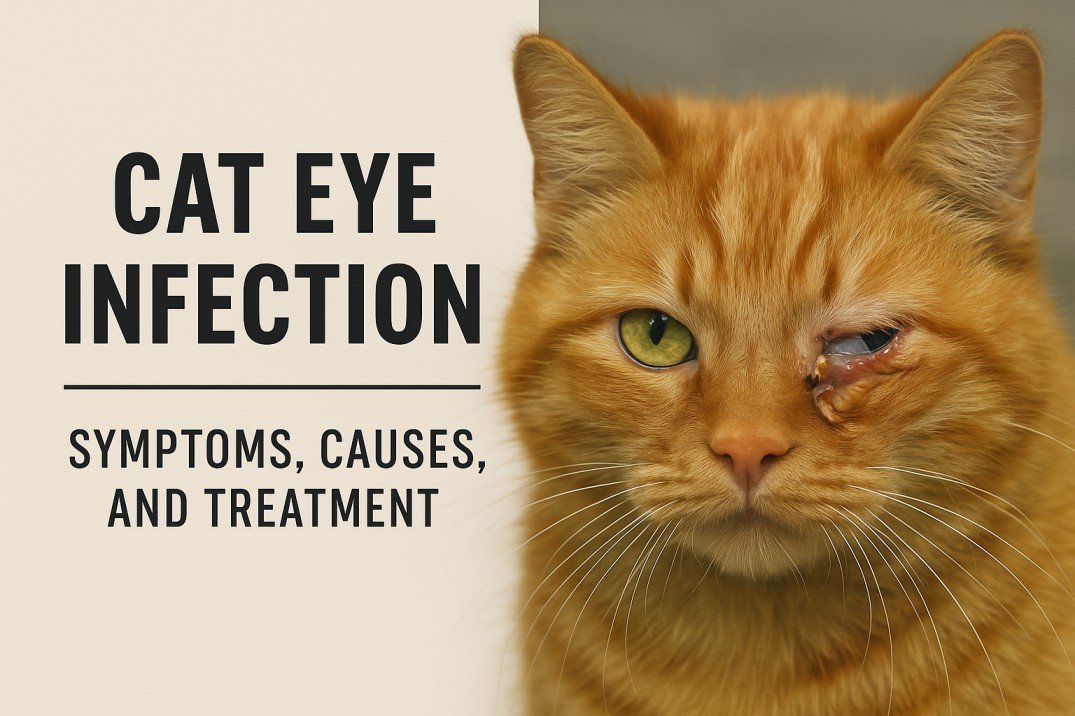Cat Eye Infection: Symptoms, Causes, and How to Treat It
Cats are known for their expressive eyes, but when those eyes become red, swollen, or filled with discharge, it’s often a sign of an eye infection. If you’ve noticed any unusual symptoms, it’s important to take them seriously. In this article, we’ll cover everything you need to know about a cat eye infection—including signs to watch for, causes, treatments, and prevention tips.
What Is a Cat Eye Infection?
A cat eye infection refers to inflammation or irritation of the eye tissue caused by bacteria, viruses, allergens, or foreign objects. The infection can affect one or both eyes and ranges from mild to severe. Some infections go away with basic care, while others require veterinary treatment.
Common Symptoms of a Cat Eye Infection
Identifying an eye infection early can make treatment easier and prevent complications. Here are the most common signs:
- Redness in or around the eye
- Swollen eyelids
- Yellow, green, or clear discharge
- Squinting or frequent blinking
- Rubbing or pawing at the eye
- Cloudy appearance or visible third eyelid
- Sensitivity to light
- Tearing or watery eyes
If you notice any of these symptoms, especially if they last more than a day, consult your veterinarian promptly.
Causes of Cat Eye Infections
Several factors can lead to an eye infection in cats. Understanding the root cause helps guide the right treatment.
1. Bacterial Infections
These are often secondary to trauma, foreign bodies, or other illnesses. Common bacteria include Staphylococcus and Chlamydophila felis.
2. Viral Infections
The most frequent viral cause is feline herpesvirus type 1 (FHV-1). This is highly contagious and can stay dormant in the body, reactivating during times of stress.
3. Fungal Infections
Less common, but fungal organisms can infect the eye if the immune system is compromised.
4. Allergies
Cats can develop allergic reactions to pollen, dust, mold, or even cleaning products. Allergic conjunctivitis presents similar symptoms but usually affects both eyes.
5. Foreign Objects
Debris like dust, fur, or grass can get stuck in the eye and cause irritation or infection.
6. Injuries or Scratches
Playtime, fights, or accidents can lead to corneal scratches, which may get infected if left untreated.
How Are Cat Eye Infections Diagnosed?
A veterinarian will typically examine your cat’s eyes using an ophthalmoscope and may perform:
- Fluorescein dye test to detect scratches or ulcers on the cornea
- Tear production test to assess eye moisture levels
- Cultures or swabs to identify bacterial or viral causes
Early diagnosis helps ensure proper treatment and avoids long-term damage to vision.
Treatment Options for Cat Eye Infections
The treatment for a cat eye infection depends on its cause and severity:
1. Antibiotic Eye Drops or Ointments
These are commonly prescribed for bacterial infections. They help reduce redness, swelling, and discharge.
2. Antiviral Medications
If herpesvirus is the cause, your vet may recommend antiviral eye drops or oral medications.
3. Anti-inflammatory Medications
Used to reduce pain, swelling, and irritation—especially in allergic or immune-related eye conditions.
4. Warm Compresses
Gently applying a warm, damp cloth to the eye can help remove discharge and soothe discomfort.
5. E-Collar
If your cat keeps scratching or pawing at the eye, an Elizabethan collar can help prevent further injury.
Important: Never use human eye drops or medications on cats unless prescribed by a vet. Some substances can be toxic.
Can a Cat Eye Infection Spread to Other Pets?
Yes. If the cause is viral or bacterial, especially with feline herpesvirus or Chlamydophila, it can spread to other cats. Isolate the infected cat, wash hands after handling, and sanitize shared items like food bowls or bedding.
Preventing Cat Eye Infections
Here are a few steps to help protect your cat’s eyes:
- Vaccinate regularly – Core vaccines can protect against herpesvirus and other common pathogens.
- Keep eyes clean – Gently wipe away discharge with a soft cloth and warm water.
- Limit exposure to allergens – Reduce dust, scented cleaners, and smoke in the home.
- Keep living spaces clean – A hygienic environment minimizes the risk of infection.
- Avoid cat fights – Indoor cats are less likely to get scratched or injured.
When to See a Vet
While some minor eye irritations resolve on their own, persistent or worsening symptoms should never be ignored. Seek veterinary help if:
- Discharge is thick, colored, or excessive
- Eye remains red or swollen for more than 48 hours
- Your cat stops eating or becomes lethargic
- The third eyelid is covering part of the eye
- Vision appears impaired or your cat is bumping into objects
Prompt treatment can prevent complications like corneal ulcers, vision loss, or chronic pain.
Conclusion
A cat eye infection can be uncomfortable and even dangerous if left untreated. By recognizing symptoms early, understanding the causes, and following your vet’s advice, you can help your feline recover quickly and maintain healthy, bright eyes. Routine care, a clean environment, and regular vet checkups go a long way in preventing future infections.








Leave feedback about this